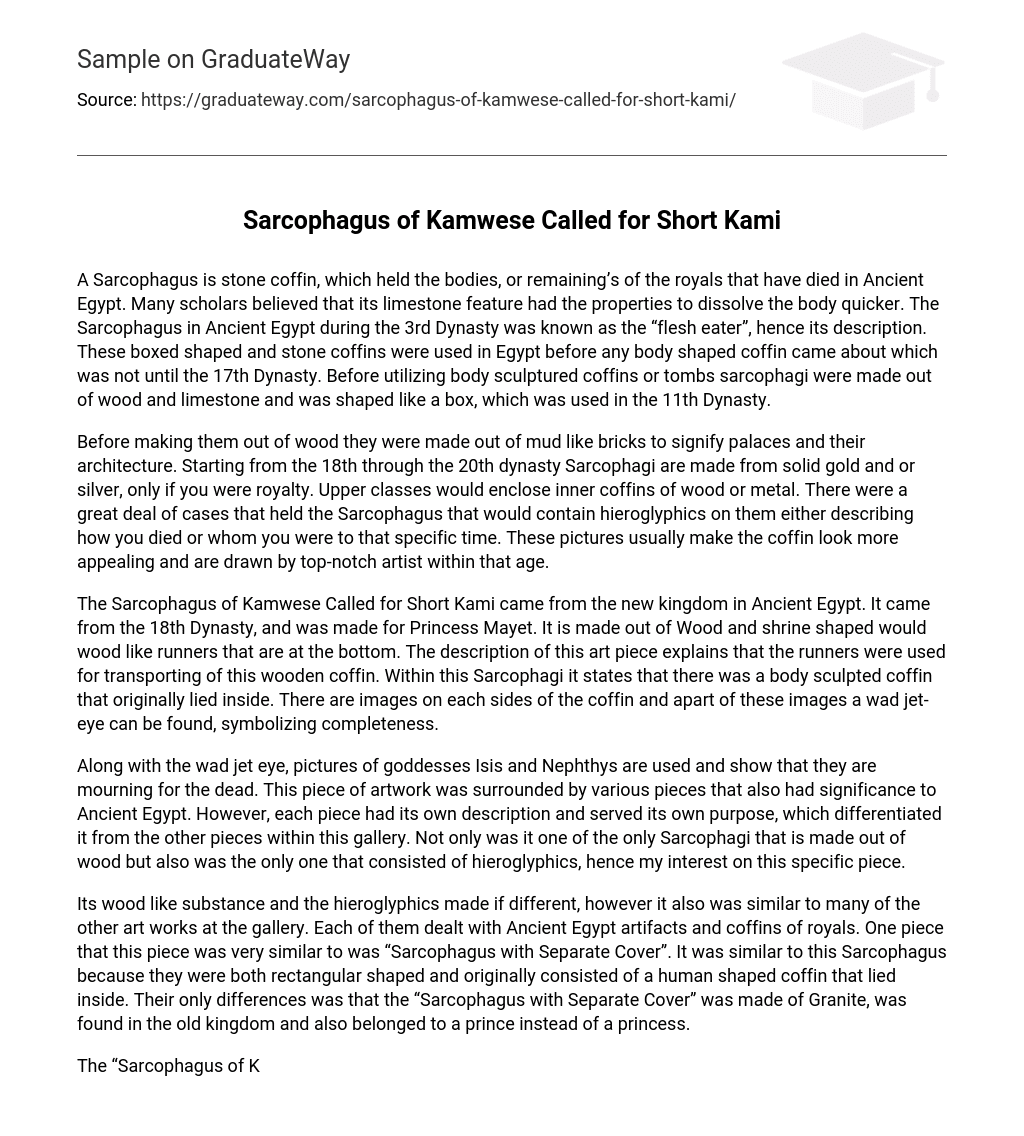A Sarcophagus is stone coffin, which held the bodies, or remaining’s of the royals that have died in Ancient Egypt. Many scholars believed that its limestone feature had the properties to dissolve the body quicker. The Sarcophagus in Ancient Egypt during the 3rd Dynasty was known as the “flesh eater”, hence its description. These boxed shaped and stone coffins were used in Egypt before any body shaped coffin came about which was not until the 17th Dynasty. Before utilizing body sculptured coffins or tombs sarcophagi were made out of wood and limestone and was shaped like a box, which was used in the 11th Dynasty.
Before making them out of wood they were made out of mud like bricks to signify palaces and their architecture. Starting from the 18th through the 20th dynasty Sarcophagi are made from solid gold and or silver, only if you were royalty. Upper classes would enclose inner coffins of wood or metal. There were a great deal of cases that held the Sarcophagus that would contain hieroglyphics on them either describing how you died or whom you were to that specific time. These pictures usually make the coffin look more appealing and are drawn by top-notch artist within that age.
The Sarcophagus of Kamwese Called for Short Kami came from the new kingdom in Ancient Egypt. It came from the 18th Dynasty, and was made for Princess Mayet. It is made out of Wood and shrine shaped would wood like runners that are at the bottom. The description of this art piece explains that the runners were used for transporting of this wooden coffin. Within this Sarcophagi it states that there was a body sculpted coffin that originally lied inside. There are images on each sides of the coffin and apart of these images a wad jet-eye can be found, symbolizing completeness.
Along with the wad jet eye, pictures of goddesses Isis and Nephthys are used and show that they are mourning for the dead. This piece of artwork was surrounded by various pieces that also had significance to Ancient Egypt. However, each piece had its own description and served its own purpose, which differentiated it from the other pieces within this gallery. Not only was it one of the only Sarcophagi that is made out of wood but also was the only one that consisted of hieroglyphics, hence my interest on this specific piece.
Its wood like substance and the hieroglyphics made if different, however it also was similar to many of the other art works at the gallery. Each of them dealt with Ancient Egypt artifacts and coffins of royals. One piece that this piece was very similar to was “Sarcophagus with Separate Cover”. It was similar to this Sarcophagus because they were both rectangular shaped and originally consisted of a human shaped coffin that lied inside. Their only differences was that the “Sarcophagus with Separate Cover” was made of Granite, was found in the old kingdom and also belonged to a prince instead of a princess.
The “Sarcophagus of Kamwese called for Short Kami”, represented its time period in various ways. In Ancient Egyptian cultures big like tombs or coffins were made for royalty. In the New Kingdom (18th dynasty) wood like Sarcophagus were made more then stone coffins. Its hieroglyphics was also a significance that represented the time period due to the old writing system in Ancient Egypt. It also consisted of two runners of the bottom, which help describe that it was lifted from one place to another. Coffins today usually stand of wheelers which helps the coffin travels from one place to another.
This Sarcophagus shows that the corps specific individual that once laid in that coffin was important to society. It states that the hieroglyphics that are on this coffin were two goddesses, Isis and Nephthys. The goddesses were both mourning the death of the princess showing that she was of matter to not only her where she ruled over but to her time as well. It was a cultural aspect in Ancient Egypt to have a symbol to describe whom you were in society on your tomb or place where you were laid to rest.
Hence the wad jet eye that is located on this coffin, signifying completeness an prosperity was usually found within the high class or royals. The wad jet eye or the eye of “Ra” is a distinct feature of the Sarcophagus due to the significance of the eye and the situation. The eye signified completeness, which also described that the princess completed her life. I seldom come across pieces that stand out as much as this Sarcophagus did. Not only was it so old but also appealing. Its hieroglyphics made it very luminance and mysterious.
From my perspective the hieroglyphics was just pictures of men like people that are looking towards an eye that looked like the letter R. However, the symbolism of these pictures told a story that described the event of this coffin. Giving it more of a value. Before reading the description of this piece, simply thought that is was a wooden box. As old and ancient as this piece may be it can still be related to contemporary life. Where coffins that people are laid to rest in tell its own story or give a description of the body that it holds with its appearance.
The hieroglyphics on this Sarcophagus shows that goddesses were mourning the death of a princess and the wad jet eye basically protected it. Similar to coffins today that can have an engraved prayer, a cross signifying the cross of Jesus. Also the qualities of a Sarcophagus to a modern day coffin would describe the wealth that an individual had. In conclusion, the “Sarcophagus of Kamwese Called for Short Kami” is a very distinct piece that tells a whole story when looking past its wood like medium and weird drawings along the sides of it.





